Input interpretation

acetophenone
Chemical names and formulas
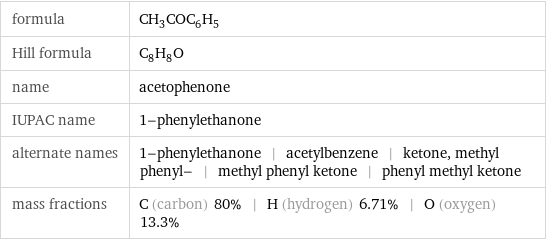
formula | CH_3COC_6H_5 Hill formula | C_8H_8O name | acetophenone IUPAC name | 1-phenylethanone alternate names | 1-phenylethanone | acetylbenzene | ketone, methyl phenyl- | methyl phenyl ketone | phenyl methyl ketone mass fractions | C (carbon) 80% | H (hydrogen) 6.71% | O (oxygen) 13.3%
Lewis structure
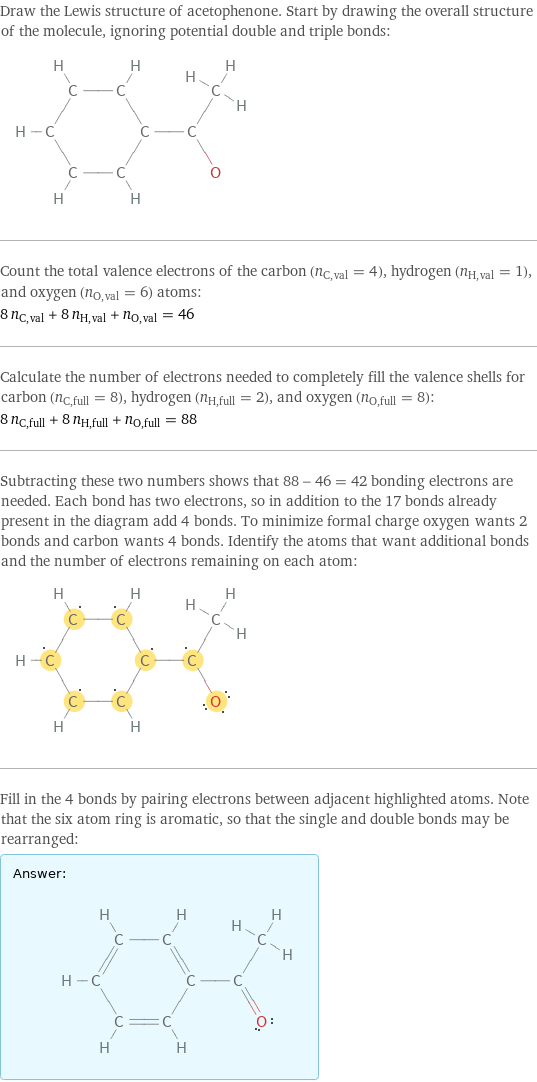
Draw the Lewis structure of acetophenone. Start by drawing the overall structure of the molecule, ignoring potential double and triple bonds: Count the total valence electrons of the carbon (n_C, val = 4), hydrogen (n_H, val = 1), and oxygen (n_O, val = 6) atoms: 8 n_C, val + 8 n_H, val + n_O, val = 46 Calculate the number of electrons needed to completely fill the valence shells for carbon (n_C, full = 8), hydrogen (n_H, full = 2), and oxygen (n_O, full = 8): 8 n_C, full + 8 n_H, full + n_O, full = 88 Subtracting these two numbers shows that 88 - 46 = 42 bonding electrons are needed. Each bond has two electrons, so in addition to the 17 bonds already present in the diagram add 4 bonds. To minimize formal charge oxygen wants 2 bonds and carbon wants 4 bonds. Identify the atoms that want additional bonds and the number of electrons remaining on each atom: Fill in the 4 bonds by pairing electrons between adjacent highlighted atoms. Note that the six atom ring is aromatic, so that the single and double bonds may be rearranged: Answer: | |
3D structure
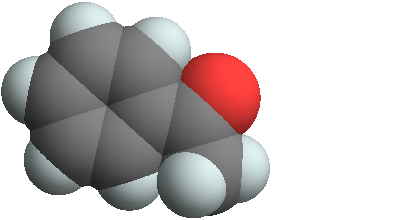
3D structure
Basic properties
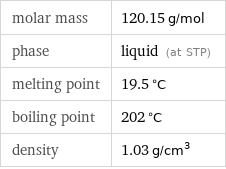
molar mass | 120.15 g/mol phase | liquid (at STP) melting point | 19.5 °C boiling point | 202 °C density | 1.03 g/cm^3
Units

Hydrophobicity and permeability properties

predicted LogP hydrophobicity | 1.65 predicted LogS | -1.95
Basic drug properties

approval status | experimental | small molecule drug categories | photosensitizing agent
Liquid properties (at STP)
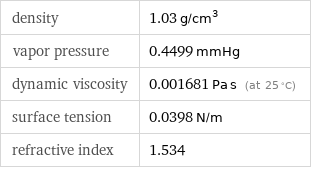
density | 1.03 g/cm^3 vapor pressure | 0.4499 mmHg dynamic viscosity | 0.001681 Pa s (at 25 °C) surface tension | 0.0398 N/m refractive index | 1.534
Units

Thermodynamic properties
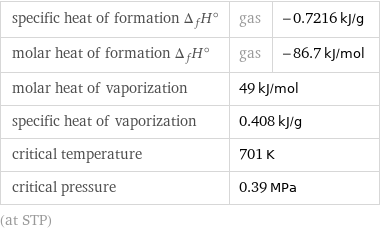
specific heat of formation Δ_fH° | gas | -0.7216 kJ/g molar heat of formation Δ_fH° | gas | -86.7 kJ/mol molar heat of vaporization | 49 kJ/mol | specific heat of vaporization | 0.408 kJ/g | critical temperature | 701 K | critical pressure | 0.39 MPa | (at STP)
Chemical identifiers
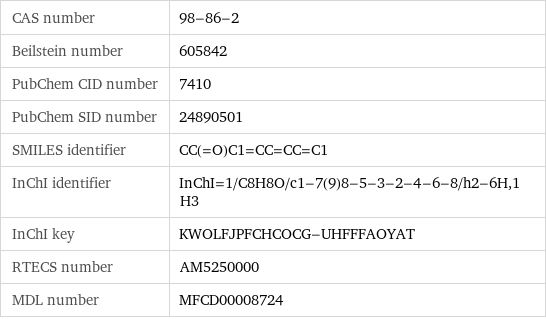
CAS number | 98-86-2 Beilstein number | 605842 PubChem CID number | 7410 PubChem SID number | 24890501 SMILES identifier | CC(=O)C1=CC=CC=C1 InChI identifier | InChI=1/C8H8O/c1-7(9)8-5-3-2-4-6-8/h2-6H, 1H3 InChI key | KWOLFJPFCHCOCG-UHFFFAOYAT RTECS number | AM5250000 MDL number | MFCD00008724
NFPA label

NFPA label
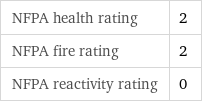
NFPA health rating | 2 NFPA fire rating | 2 NFPA reactivity rating | 0
Safety properties
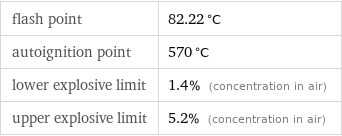
flash point | 82.22 °C autoignition point | 570 °C lower explosive limit | 1.4% (concentration in air) upper explosive limit | 5.2% (concentration in air)

DOT hazard class | 3 DOT numbers | 1993
Toxicity properties

lethal dosage | 815 mg/kg (oral dose for rats) threshold limit value | 10 ppmv

probable lethal dose for man | 600 mL (milliliters) RTECS classes | mutagen | primary irritant